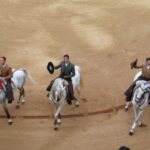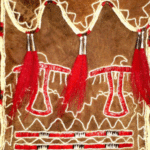1) Name: Sitting Bull
Indian Name: Tatanka Iyotanka
Birth: 1831
Death: 12-15-1890
Nation: Hunkpapa Sioux
Why: He is seen as a symbol of resistance by American Indians, especially the Lakota Nation. In a 1997 documentary titled The Great Tribes, he is noted as a renaissance man, holy man, great warrior, hard-bargaining politician, composer of songs and an artist. His notoriety started when he refused to sign the Treaty of 1868. Under him, the Sioux and Cheyenne Nations unified. Those that chose to live on the reservation, he chastised. A descendant of his, Isaac Dog Eagle, added in that he had the ability to see visions to understand as well as to foresee things. He was scheduled to go on a European tour with Buffalo Bill Cody in 1887, but turned it down for fear of more land being taken away from his people.
2) Name: Hiawatha
Indian Name: Aiionwatha (Ayonwatha) meaning “He Makes Rivers”
Birth: Unknown
Death: Unknown
Nation: Iroquois
Why: He persuaded the Five Nations consisting of the Mohawk, Oneida, Cayuga, Seneca and Onondaga Nations to stop bickering among each other. He invented a form of communication known as Sign Writing. According to Alma Burton Holman’s Builders of our Nation, meaningful shapes and figures were painted onto birch bark.
3) Name: Crazy Horse
Indian Name: Thasunke Witko meaning “His-Horse-Is-Crazy”
Birth: 1842
Death:9-5-1877
Nation: Lakota
Why: He was compared to Chief Joseph as being “modest and courteous” as well as a gentle warrior who stood for the highest ideal of the Sioux. Charles A.Eastman notes in his book titled Indian Heroes and Great Chieftains that he never took part in discussion held by chiefs who wanted to remain peaceful and make treaties. And was described as a “man of deeds and not of words.”
4) Name: Geronimo
Indian Name: Goyathla/Goyathlay meaning “One Who Yawns”
Birth: 6-16-1829
Death: 2-17-1909
Nation: Chiricahua Apache( Bedonkohe)
Why: His source of power started after a tragic event. According to Robert M. Utley (Historian) in a documentary titled The Real West-Geronimo: The Last Renegade, Mexican soldiers fell on an Apache camp in 1850, killing his mother, wife and children. Soon after, his power came in a bloody rampage against the white eye and the Mexicans. Kenny Rogers notes that his reputation became a symbol in the American Indian’s fight for freedom. With it consisted of wisdom, bravery and brutality. He is also known for choosing life on the run over confinement to a reservation in San Carlos, a place strongly despised by him as well as the Apache people. He was also known for riding alongside Quanah Parker and other noted Indian leaders in President Roosevelt’s 1905 inaugural parade.
5)Name: Quanah Parker
Indian Name: Quanah meaning “Sweet Odor” or “Bed of Flowers”
Birth:1854
Death:2-23-1911
Nation: Kwahadi Comanche
Why: In 1865, according to Charles A. Eastman, the chiefs from the Plains Indian Nations along with the Kansas Indians had signed a treaty that would end Indian warfare. This treaty was referred to as the Medicine Lodge Treaty. He refused to compromise with the whites due to them taking land from his people.
6) Name: Chief Spotted Elk
Indian Name: Hehaka Gleska
Birth:1826
Death:12-29-1890
Nation: Minniconjou Band of Lakota Sioux
Why: According to wikipedia, he became chief of the Minniconjou Band after the passing of his father. After surrendering, he fell ill with pneumonia and was given a tent which included a hot oven to keep him warm. Sadly, he was killed alongside 300 Minniconjou Lakota men, women and children during the massacre at Wounded Knee Creek in Wounded Knee, South Dakota.
7)Name: Chief Joseph
Indian Name: Heinmot Tooyalaket meaning “Thunder Rolling in the Mountains”
Birth:3-3-1840
Death:9-21-1904
Nation: Walla Walla Band of the Nez Perce
Why: He, just like Chief Black Kettle of the Cheyenne, was also a chief of peace. He followed in footsteps of his father and pledged to keep the land which his people freely thrived upon. According to Kent Nerburn in Chief Joseph & the flight of the Nez Perce: the untold story of the American Tragedy, his only wish was for his people to be left alone living the traditional way.
8)Name: Red Cloud
Indian Name: Mahpiya Luta
Birth:1822
Death: 12-10-1909
Nation: Lakota Sioux
Why: He protested the movement of the white settlers entering into the Black Hills. In 1868, he refused to sign the Treaty which stated that the Black Hills ( Paha Sapa) along with the Big Horn were territory belonging to the Lakota people. The Treaty also stated that these areas were not allowed to be entered unless permitted by the Indians to do so. He refused to place his signature onto it until his demands were met. According to a book written by Charles A. Eastman titled Indian Heroes and Great Chieftains, he wanted the forts within the territory vacated. The government complied and were said to have abandoned the new road and withdrew the garrisons.
9) Name: Lozen
Indian Name: Unknown
Birth: late 1840s
Death: 1890
Nation: Chihenne-Chiricahua band of Apache
Why: Known as the younger sister of the Mimbreno Apache chief Victorio, she was a shaman who was devoted to her people. She was credited in Peter Aleshire’s Warrior Woman: the story of Lozen, Apache Warrior and Shaman for excelling in stealing horses. This skill was noted as”one of the most honored skills among the Apache.”
10) Name: Cochise
Indian Name: K’uu-chi’ish meaning “firewood”
Birth: 1815
Death: 6-8-1874
Nation: Chiricahua Apache (Chokonen)
Why: He, similar to Crazy Horse, did not have photos taken of himself. He was invited by the government to Washington. The goal set was to help bring peace in the Apache country. But, like Sitting Bull, he declined due to issues of trust with the United States military as well as the civilian representatives. By the white people who knew him, he was described to be gentle in his manners. They also noted that his appearance was neat and clean. In a 1993 movie titled Geronimo: An American Legend, General Crook (played by Gene Hackman) described him as a “king” and a “wise ruler” of his people.
11) Name: Jakonsahseh
Birth: Unknown
Death: Unknown
Nation: Unknown
Why: Known as “the mother of nations, she was the first to accept the Great Law, which became the unification unit of the Six Nations into the Haudenosaunee Confederacy. Followed by her influence of acceptance were Hiawatha and the Peacemaker. This took place in 909 CE.
12) Name: Tecumseh
Indian Name: Tecumtha or Tekamthi
Birth: March 1768
Death: 10-15-1813
Nation: Shawnee
Why: According to Andrew Warrior ( Absentee Shawnee) from a PBS Documentary titled We Shall Remain, Tecumseh had a vision. Its goal was to make sure that there was continuance of the traditional Indian way of life. Another Absentee Shawnee named Kevin Williams noted that he and his brother, Tenskwatawa, were trying to get the Shawnee people back to their roots and trying to keep their land from being taken. Kevin described him as a “visionary.”
13) Name: Tenskwatawa The Prophet
Indian Name: Lalawethika meaning “The Noise Maker”
Birth: 1755
Death: November 1836
Nation: Shawnee
Why: He was the guiding force behind the Pan-Indian Movement established by his older brother, Tecumseh. After suffering a near death experience and sobering up from alcohol, he devoted himself to reclaiming the traditional Indian way of life. According to a PBS documentary titled We Shall Remain, Tenskwatawa was known to have engaged in a series of confrontations, one in which he engaged in the killing of a leader belonging to the Wyandotte Nation; he was accused of being a witch. He told the Indians of all nations that they needed to better themselves. In doing so, wearing the white man’s apparel was forbidden. He also forbade the consumption of alcohol, for it causes drunkenness which is said to be “displeasing to the Great Spirit.” Aside from the Shawnee, Indians belonging to the Delaware, Wyandotte, Kickapoo and Potawattomi Nations also came to listen to his words.
14) Name: Jim Thorpe
Indian Name: Wa-Tho-Huk
Birth: 5-28-1888
Death: 3-28-1953
Nation(s): Sac and Fox
Why: “You are an Indian. I want you to show other races what an Indian can do.” Those were the last words told to him by his father, Hiram, before his passing. After enrolling himself in Carlisle School, he scored 5 touchdowns in the 1st football game. According to a 2009 documentary titled Jim Thorpe, The World’s Greatest Athlete, the game of Football was crowned “King” and noted as a chance for Indian Athletes to stand up against white opponents and win.
15) Name: Dahteste
Indian Name: Unknown
Birth: Unknown
Death: Unknown
Nation: Mescalero Apache
Why: Married with children, she walked the warrior’s path. Gretchen Bataille and Laurie Lisa note her in Native American Women: a biographical dictionary as a skillful rider and hunter who took part in raids alongside her husband.
16) Name: Morning Star also known as Dull Knife
Indian Name: Motseske Ohnexapho ( Cheyenne) & Tamilapesni (Lakota)
Birth:1810
Death:1879
Nation: Northern Cheyenne
Why: Dull Knife is described by Richard B. Williams (Northern Cheyenne/Lakota) in a 1997 documentary titled The Great Tribes as ” a respected leader” who led his people in peace and war. He is also described as the “wiser one” who provided council. Upon that, he tried to steer his people away from trouble. Charles A. Eastman described him in his book titled Indian Heroes and great Chieftains as “child-like yet manful, and that he was an old school chief.
17) Name:Chief Black Kettle
Indian Name: Motavato
Birth:1803
Death:11-27-1868
Nation: Southern Cheyenne
Why: He sought peace for his people. According to George Bent, he is described to be “a fine man” and that he was highly respected by all who knew him.
18) Name: Manuelito
Indian Name(s): Askkii Dighin (Holy Boy), Dahaana Baadaane (Son-in-Law of Late Texan), Hastiin Ch’ilhaajin (“Black Weeds”), Nabaah Jilt’aa (War Chief, “Warrior Grabbed Enemy”)
Birth:1818
Death:1893
Nation: Navaho
Why: As principal chief, he went out of his way to live peacefully. However, things changed. According to Chapter 2 titled The Long Walk of the Navahos in Bury My Heart At Wounded Knee by Dee Brown, his anger with the Americans fueled when his village was decimated. Hogans were burned and all his livestock were killed. This was used as a punishment for a few wrongdoings committed by some Navahos, who were said to have been “mischievous.”
www.pbs.org
www.books.google.com
http://en.wikipedia.org





